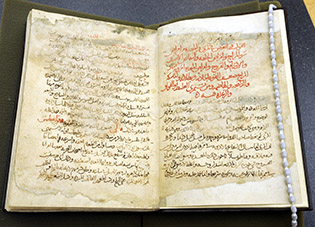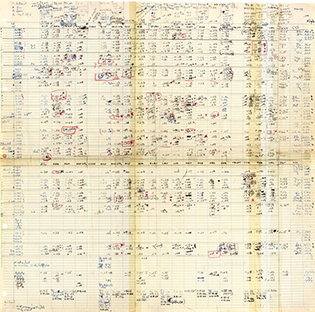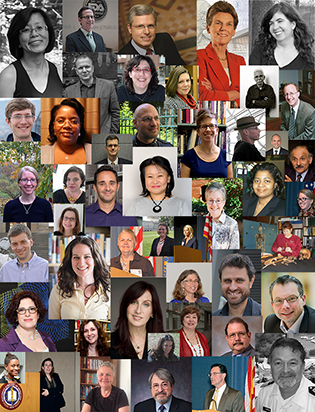Digitizing and Preserving Medical History
Embracing the Future as a Steward of Medical Heritage
Libraries around the world are digitizing their historical treasures and making them more accessible via the Internet than ever before. Leading the way is the National Library of Medicine (NLM), the world’s largest biomedical library, located on the NIH campus in Bethesda, Maryland.
The NLM traces its origins to 1836, when it consisted of a few dozen books in what was then the Library of the Office of the Surgeon General of the United States Army. Since then, its vast collections have been built over multiple generations, literally passed down from one generation to the next, and they contain material from antiquity to the present and nearly every part of the world: from books, journals, photographs, and films and videos to artwork, postcards, pamphlets, and much, much more.
The library opened its doors on the NIH Bethesda campus in 1962, and it has served the world ever since in translating biomedical research into practice, in leading in information innovation, and, every day via the Internet, in serving millions of scientists, health professionals, and members of the public.
The NLM holds one of the world’s largest and most treasured collections that includes both historical and contemporary items in a variety of media. We welcome everyone to learn more about it, whether by visiting us onsite for a tour or online via the NLM’s website (https://www.nlm.nih.gov/).

NLM
The Arabic manuscript entitled The Comprehensive Book on Medicine, dated 1094, is the oldest item in NLM’s collection.
One of the library’s oldest items dates from the year 1094. It is an Arabic manuscript entitled The Comprehensive Book on Medicine (Kitab al-Hawi fi al-tibb), by one of the era’s great physicians, Abū Bakr Muhammad ibn Zakarīyā al-Rāzī (circa 850–circa 925), known in the Western world as Rhazes.
The NLM’s newest collections, comprising websites and social media about the recent Ebola and Zika outbreaks, will be the historical records of the future. And perhaps one of the most remarkable 20th-century items held by the NLM, and available for anyone to explore online—both via NLM Profiles in Science and Turning the Pages—and experience through a traditional visit to the NLM, is the first summary of the genetic code—on several sheets of standard, taped-together paper—by 1968 Nobel laureate Marshall Nirenberg, whose research career at NIH spanned 50 years.

NLM
The NLM has the first summary of the genetic code—on several sheets of standard, taped-together paper—by 1968 Nobel laureate Marshall Nirenberg, whose research career at NIH spanned 50 years.
Scholars from around the world use the NLM’s historical collections to advance their research. Educators use them to teach and inspire. Students use them to learn about the human condition. By carefully digitizing these collections and making them more accessible than ever before, we’re liberating a global and centuries-long record of medicine to help inform research, education, and learning in the 21st century. The NLM’s Digital Collections repository currently offers more than 80,000 items, including books, films, and images, and is rapidly growing. This resource complements PubMed Central (http://www.ncbi.nlm.nih.gov/pmc/), NLM’s free, full-text archive of biomedical and life-sciences journal literature, now including 3.9 million articles spanning the early 19th-century to the present day.
But digitization is only part of the story. Our responsibility extends to being a good steward of this globally appreciated collection, and stewardship means preserving it for future generations by taking good care of it both during and long after we make digital copies of it. It also means ensuring that a wide audience knows about and appreciates the collection for the vast knowledge and experience it can offer to researchers, educators, students, and members of the interested public.
The NLM’s award-winning exhibition program has been achieving this last goal for many years, revealing important stories about the human condition to hundreds of thousands of individuals via its traveling banner exhibitions that travel the world and to millions more via its companion exhibitions on the web. The NLM’s popular blog, Circulating Now, which recently marked its third anniversary, shines a light every week onto the rich collections of the library. (See sidebar.)
Hand in hand with curating its collections in these ways, the NLM is actively working with other organizations such as the National Endowment for the Humanities (NEH) to support new ways of studying its growing digitized collections and related data sets as well as the related digitized collections and associated data of historical medical libraries and archives around the world. Along these lines, during the past three years, NLM and NEH have collaborated on several initiatives in cooperation with several organizations and institutions, including the Maryland Institute for Technology in the Humanities of the University of Maryland (College Park, Maryland), Research Councils UK, Virginia Polytechnic Institute and State University (Blacksburg, Virginia), The Wellcome Library (London), and The Wellcome Trust (London). Most recently, on April 11–13, the NLM hosted the NEH-funded interdisciplinary workshop “Images and Texts in Medical History: An Introduction to Methods, Tools, and Data from the Digital Humanities” (see description).
To learn more about NLM’s partnership with the NEH and how it developed through interagency collaboration, visit https://www.td.org/Publications/Magazines/The-Public-Manager/Archives/2016/07/Synergy-for-the-Greater-Good.
Group tours of NLM’s History of Medicine Division or of the entire library are easily arranged. Go to http://www.nlm.nih.gov/about/vcenter.html for tours of the entire library, or contact hmdref@nlm.nih.gov for tours of the History of Medicine Division only.
Three Times Around and Still Circulating
POSTED BY CIRCULATING NOW ON JULY 1, 2016, IN COLLECTIONS, NEWS

NLM
Some of the many contributors to NLM’s Circulating Now blog.
Three years ago this week, we launched the website Circulating Now to explore, share, and celebrate the value of the NLM’s world-renowned historical collections and programs for research, education, enrichment, and learning about the human condition.
By several measures, we’ve achieved our goal. In three years Circulating Now has given voice to over 100 individuals—from guest writers to event speakers to our own talented staff—who have shared their own perspectives and meaningful interactions with our collections and with related programs and resources.
With over 500 posts, Circulating Now has offered readers worldwide insights on a wide and wonderful range of subjects in the history of medicine—military history, women’s history, African-American history; public health, advocacy, legislation; botany, genetics, biotechnology; to name just a few.
Circulating Now has showcased the varied formats of the NLM’s historical collections, enabling readers to experience and learn from our monographs, manuscripts, photographs and prints, films, audio files, and born-digital collections. And it has highlighted the range of NLM resources that support historical research and make the collections available—from the NLM’s Digital Collections to the IndexCat database of millions of bibliographic citations spanning centuries; from the NLM’s award-winning Exhibition Program to historical content in PubMed Central; and from “Profiles in Science” to “Medical Movies on the Web”.
Read more online at https://circulatingnow.nlm.nih.gov/2016/07/01/three-times-around-and-still-circulating/.
This page was last updated on Wednesday, April 13, 2022
